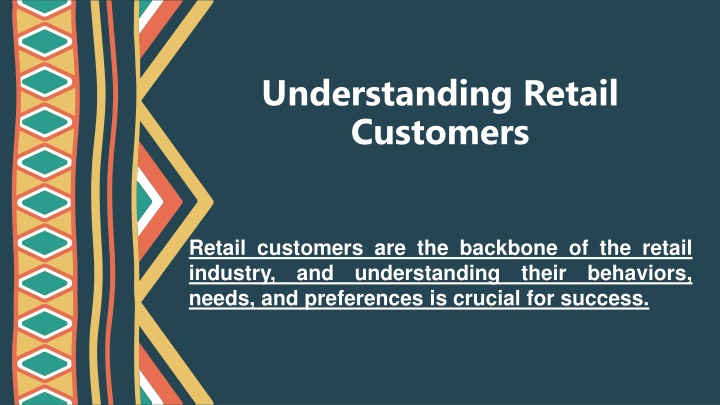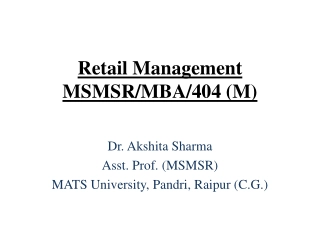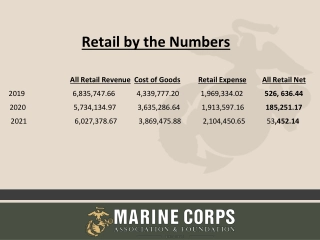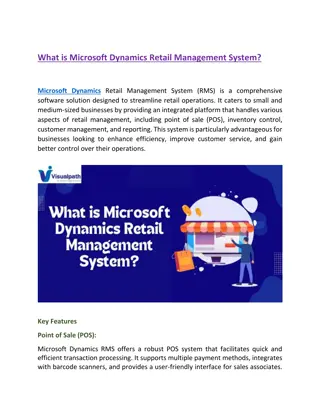
Understanding Retail Customers: Importance, Factors, and Strategies
Understanding retail customers is essential in the retail industry for tailored offerings, enhanced marketing strategies, and increased loyalty. Learn about the definition, importance, and key factors influencing retail customers like personal, psychological, social, cultural, economic, technological, environmental factors, and retail-specific factors.
Download Presentation

Please find below an Image/Link to download the presentation.
The content on the website is provided AS IS for your information and personal use only. It may not be sold, licensed, or shared on other websites without obtaining consent from the author. If you encounter any issues during the download, it is possible that the publisher has removed the file from their server.
You are allowed to download the files provided on this website for personal or commercial use, subject to the condition that they are used lawfully. All files are the property of their respective owners.
The content on the website is provided AS IS for your information and personal use only. It may not be sold, licensed, or shared on other websites without obtaining consent from the author.
E N D
Presentation Transcript
Understanding Retail Customers Retail customers are the backbone of the retail industry, and understanding their behaviors, needs, and preferences is crucial for success.
Definition of Retail Customers Retail customers are individuals or groups who purchase products or services from a retail store for personal or household use. They differ from wholesale buyers who purchase in bulk for resale.
Importance of understanding Retail customers Tailored Offerings: Helps retailers customize their products and services to meet specific customer needs. Satisfaction: By understanding Enhanced preferences, retailers can deliver better shopping experiences. Customer Improved Marketing Strategies: Knowing customer behavior enables targeted marketing and promotions. Increased Loyalty: Personalized interactions foster trust and long-term relationships.
Key Factors Influencing Retail Customers 1. PERSONAL FACTORS 2. PSYCHOLOGICAL FACTORS 3. SOCIAL FACTORS 4. CULTURAL FACTORS 5. ECONOMIC FACTORS 6. TECHNOLOGICAL FACTORS 7. ENVIRONMENTAL FACTORS 8. RETAIL SPECIFIC FACTORS
PERSONAL FACTORS A. Age and Life Stage - Younger consumers may prioritize trendy, affordable products, while older individuals may focus on quality and reliability. Life stages (single, married, with children, retired) influence product preferences. For instance, families with children may prioritize convenience and bulk purchases. B. Income Level= Disposable income dictates spending power. High-income groups may prefer premium brands, while budget-conscious consumers seek discounts and value-for-money products. C. Occupation and Lifestyle- Professional individuals may focus on business attire and gadgets, while students prioritize casual wear and tech products. Lifestyle preferences, such as eco-consciousness or minimalism, guide choices toward sustainable or multifunctional items. D. Gender- Gender-specific preferences impact product types, marketing, and store layouts. For example, men may value speed in shopping, while women might prioritize variety and personalization.
Psychological Factors - Psychological drivers shape consumer attitudes and perceptions toward products and brands: A. Motivation Driven by Maslow s hierarchy of needs, customers prioritize products based on their basic, safety, social, esteem, or self-actualization needs. Example: A basic need may lead to grocery purchases, while self-actualization could drive luxury or experiential purchases. B. Perception How a consumer views a product or store influences their decision. Factors like store ambiance, packaging, or product placement shape these perceptions. Example: Premium packaging may convey high quality, encouraging purchase. C. Attitude Long-term attitudes toward a brand or product influence buying behavior. A positive past experience can lead to repeat purchases. D. Learning Customer behavior evolves with experience. Positive experiences with a product or promotional offers may reinforce brand loyalty.
Social Factors The social environment of the customer impacts their retail behavior: A. Family Family members influence purchasing decisions, especially for products like groceries, appliances, or furniture. Example: Parents may prioritize quality, while children influence preferences for toys or snacks. B. Reference Groups Friends, colleagues, or social groups impact brand choices through word-of-mouth or visible trends. Example: A recommendation from a friend about a new electronic gadget can drive purchases. C. Social Status Social class influences preferences for luxury versus utility products. Higher classes might lean toward branded or exclusive items.
Cultural Factors A. Cultural Norms Values, traditions, and societal expectations shape product preferences and shopping habits. Example: During festive seasons in India, traditional attire and sweets see a surge in demand. B. Subcultures Regional and ethnic subcultures influence specific product preferences. Example: A retailer in Southern India might stock sarees and local spices to cater to regional demand.
Economic Factors A. Economic Stability In times of economic growth, consumers are likely to spend more on discretionary items. Recessions lead to a focus on necessities. B. Price Sensitivity Discounts, offers, and competitive pricing are significant motivators for price-sensitive consumers. c. Employment Status Employment levels impact disposable income and buying power. Unemployed individuals prioritize basic needs over luxury products.
RETAIL CUSTOMERS - Conclusion Retail customers are individuals or groups who purchase goods or services directly from retail outlets for personal or household use. They are influenced by various factors, including personal needs, income levels, cultural and social norms, psychological motivations, and external market conditions. Retail customers exhibit diverse buying behaviors shaped by demographics, lifestyle, and preferences. They seek value, convenience, and quality while being influenced by promotions, customer service, and store ambiance. Understanding retail customers helps businesses tailor their offerings, enhance customer satisfaction, and foster loyalty. Their behavior directly impacts inventory, pricing, marketing strategies, and the overall success of a retail business.
Questions & answers Invite questions from the audience






















